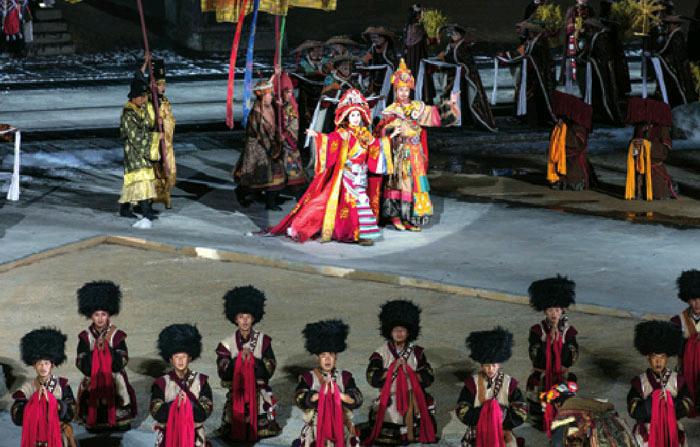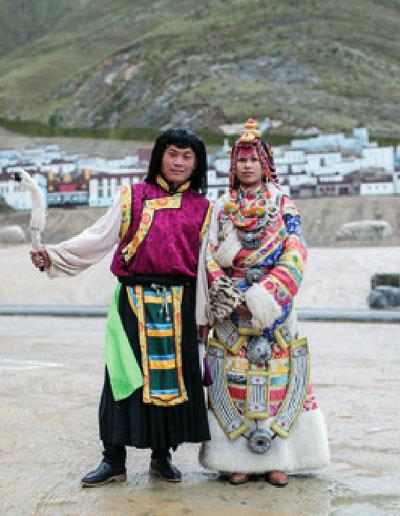The Value of Art
2015-09-08ByHouWeili
By+Hou+Weili
Loten regards 2013 as the year that changed his life. It was when his artistic dream was realized and love came a-calling.
The young Tibetan hails from Cijiaolin, a village in Lhasa, capital of the Tibet Autonomous Region.
“[Now] I can have a daytime job while working as a dancer at night. From the latter, I can earn over 3,000 yuan ($468),” Loten told ChinAfrica.
The dancing that occupies Lotens nights is part of the legendary Tibetan live-action drama, Princess Wencheng. It was at the audition for one of the roles that Loten met his future wife, Pasang Chodron, also a dancer, in May 2013.
Performed in an open-air theater opposite the iconic Potala Palace with its natural mountain backdrop, the drama tells the story of how Princess Wencheng of the Tang Dynasty (618-907) trekked westward for three years to marry Songtsan Gambo, the king of Tubo Kingdom, todays Tibet. This interracial matrimony helped bring closer the ties between the Tang and Tubo courts as well as to bridge the different cultures.
Integrating many Tibetan folk arts, like drum dancing, Tibetan opera and Buddhist chants, the drama is an example of an art form successfully generating revenue for the local cultural sector. The regional governments 2015 work report in March showed the sectors output in 2014 was 2.7 billion yuan ($420 million), an increase of 12 percent year on year, accounting for 2 percent of Tibets GDP. The success of the cultural sector means Tibets folk arts are enjoyed by a wide audience and the generated revenue can improve peoples lives.
Born performers
Tibet is rich in art forms and the government has been highlighting policies to promote them by establishing museums and libraries to exhibit and conserve folk arts and theaters in which to perform them. Today there are theaters in every prefecture, comprehensive recreation centers in every county, and cultural activity centers in every town, according to Tibet regional authorities.
As cultural facilities improve, peoples mindsets toward art are changing, seeing it as more than tradition. “With cultural works, as represented by Princess Wencheng, people are becoming aware that art and culture can generate economic returns,” said Wu Yasong, Vice Mayor of Lhasa.
For the ordinary Tibetans, who are born singers and dancers, their performance embodies the essence of their people. “The moment I am on stage, I am excited and motivated to please the audience,” said Loten. Apart from the heroine and hero and respective alternates, the entire Princess Wencheng cast of more than 600 characters, varying in age from 18 to 70, are performed by locals like Loten and his wife.
“They are savvy and able to fully depict the characters they play without training,”said Qiu Wei, CEO of the Usunhome Culture Investment Group that has invested in the drama. “In the near future, the leads will also be played by locals.”
A blockbuster
This spectacular performance by over 600 people awes audiences with its grandeur and elaborateness. “The drama has been so well-received that tickets are always sold out,” said Loten.
Statistics from the investor show that in just four months after its premiere on August 1, 2013, the dramas box-office revenue amounted to 29 million yuan ($4.5 million). In 2014, that figure hit 110 million yuan ($17 million). It is expected to reach 150 million yuan ($23.4 million) this year.
However, the box-office revenue represents only a sliver of the planned future returns. Usunhome is working with the local government to develop derivatives of the drama and establish supporting commercial facilities including restaurants, boutiques and hotels. “In many peoples eyes, Tibet is a sacred place that everyone should visit at least once. This means a great opportunity for us. Visits mean there will be consumption,” said Qiu.
He now plans to turn the theaters surroundings into an entertainment and recreation center, featuring cultural drama and displays of Tibetan culture.
In 2014, Tibet received 15.53 million tourists, up 20 percent year on year, and raked in 20 billion yuan ($3 billion) as revenue, official statistics showed.
By 2020, the government plans to build five national and 20 regional demonstration parks for the cultural sector, making it one of the major revenue earners. The sector, it is estimated, will then employ 30,000 people and contribute 5 percent to the regional GDP. It means more locals like Loten will benefit.
